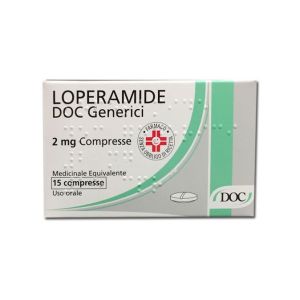Ship in Europe, Find out rates!
Loperamide Doc Generici 2 mg Diarrhea 15 Tablets

- box Delivery in Italy in 24/48 and free returns
- star3.000+ positive reviews
- dropboxOver 60,000 products in the catalog
Tablets based on Loperamide hydrochloride .
Therapeutic indications
Loperamide Hexal is used in the treatment of acute diarrhea.
Dosage and Posology
The drug should be taken according to the following doses and methods:
- Adults and children between the ages of 6 and 17
The tablets should be taken with some liquid
- Acute diarrhea: the starting dose is 2 tablets (4 mg) for adults and 1 tablet (2 mg) for children; thereafter 1 tablet (2 mg) after each subsequent evacuation of unformed (soft) faeces.
- Chronic diarrhea: the starting dose is 2 tablets (4 mg) for adults and 1 tablet (2 mg) for children per day; this starting dose should be adjusted until 1- 2 solid bowel movements are achieved per day, which is usually achieved with a maintenance dose of 1-6 tablets (2 mg -12 mg) per day. The maximum daily dose for chronic and acute diarrhea is 8 tablets (16 mg) per day for adults; in children the dose should be related to body weight (3 tablets / 20 kg) but should not exceed a maximum of 8 tablets per day.
- Children under 2 years of age
Loperamide Doc Generici should not be used in children less than 2 years of age.
No dose adjustment is necessary in the elderly. No dose adjustment is required in patients with renal impairment. Although no pharmacokinetic data are available in patients with hepatic impairment, Loperamide Doc Generici should be used with caution in these patients due to impaired first pass metabolism.
Overdose
In case of overdose (including relative overdose, due to liver dysfunction) CNS depression (stupor, coordination abnormalities, somnolence, miosis, muscle hypertonia and respiratory depression), urinary retention and ileus may occur. Children may be more sensitive to central nervous system effects than adults. Therefore it is recommended to keep the product out of their reach because in cases of erroneous administration in children under 4 years of age, for absolute overdose (accidental intake of excessive doses) or relative (for accumulation in the blood of drug not metabolized, even if administered at the correct doses), constipation may occur and, as with many other drugs (e.g. sulfonamides), in the case of immaturity of the blood-brain barrier, undesirable effects such as central nervous system depression, accompanied by drowsiness and bradypnea . In this case, the patient should be kept under careful observation for 48 hours in order to highlight a possible depression of the central nervous system.
Measures in case of overdose: gastric lavage, inducement of vomiting, enema or administration of laxatives. If symptoms of overdose develop, naloxone can be given as an antidote. Since the duration of action of loperamide is longer than that of naloxone (1 to 3 hours), repeated treatment with naloxone may be indicated. Therefore the patient should be monitored closely for at least 48 hours in order to detect any CNS depression.
Contraindications
- Hypersensitivity to the active substance or to any of the excipients
- In children under 2 years of age.
- In patients with acute dysentery characterized by blood in the stool and high fever in patients with acute ulcerative colitis in patients with bacterial enterocolitis caused by invasive organisms including Salmonella, Shigella and Campilobacter in patients with pseudomembranous colitis associated with the use of broad spectrum antibiotics.
- When inhibition of peristalsis should be avoided due to the possible risk of significant consequences including ileus, megacolon and toxic megacolon.
- Treatment with Loperamide Doc Generici should be stopped immediately when constipation, abdominal distension or ileus occurs.
Side effects
- Adults and children aged ≥12 years
The safety of loperamide hydrochloride was evaluated in 3076 adults and children aged ≥12 years who participated in 31 controlled and uncontrolled clinical trials with loperamide hydrochloride used for the treatment of diarrhea. Of these, 26 studies were on acute diarrhea (N = 2755) and 5 on chronic diarrhea (N = 321). The most commonly reported adverse drug reactions (ADRs) (i.e. with an incidence ≥1%) in clinical trials with loperamide hydrochloride for the treatment of acute diarrhea were: constipation (2.7%), flatulence ( 1.7%), headache (1.2%) and nausea (1.1%). In clinical trials for the treatment of chronic diarrhea the most commonly reported ADRs (i.e. with an incidence ≥1%) were: flatulence (2.8%), constipation (2.2%), nausea (1.2 %) and dizziness (1.2%). The data in Table 1 represent the results from 3,076 adults and children aged ≥12 years who participated in 31 controlled and uncontrolled clinical trials with loperamide hydrochloride used for the treatment of diarrhea. Of these, 26 studies were on acute diarrhea (N = 2755) and 5 on chronic diarrhea (N = 321). The frequency categories in Table 1 are defined according to the following convention: very common (≥ 1/10), common (≥ 1/100 to <1/10), uncommon (≥ 1 / 1,000 to <1/100 ), rare (≥ 1 / 10,000, <1 / 1,000) and very rare (<1 / 10,000)
Frequency of adverse drug reactions reported with the use of loperamide hydrochloride during clinical trials in adults and children aged ≥12 years
- Nervous system disorders
- Acute diarrhea: Headache (Common), Dizziness (Uncommon)
- Chronic Diarrhea: Headache (Uncommon), Dizziness (Common)
- Gastrointestinal disorders
- Diarrhea Acute: Constipation, nausea, flatulence (Common), Abdominal pain, abdominal discomfort, dry mouth (Uncommon), Abdominal pain upper, vomiting (Uncommon), Abdominal distension (Rare)
- Chronic diarrhea: Constipation, nausea, flatulence (Common), Abdominal pain, abdominal discomfort, dry mouth (Uncommon), Dyspepsia (Uncommon)
- Skin and subcutaneous tissue disorders
- Acute Diarrhea: Rash (Uncommon)
The post-marketing adverse reaction reporting process for loperamide did not differentiate between indications for the treatment of chronic versus acute diarrhea or between adults and children; consequently, the post-marketing adverse reactions for loperamide listed below are cumulative for the two indications and patient populations. Adverse reactions identified post marketing for loperamide hydrochloride are listed below by MedDRA Dictionary System Organ Class and Preferred Terms (PT).
- Immune system disorders: Hypersensitivity reaction, Anaphylactic reaction (including anaphylactic shock), Anaphylactoid reaction
- Nervous system disorders: Somnolence, loss of consciousness, stupor, depressed level of consciousness, hypertonia, coordination disturbances
- Eye disorders: Miosis
- Gastrointestinal disorders: Ileus (including paralytic ileus), megacolon (including toxic megacolon) and glossodynia
- Skin and subcutaneous tissue disorders: Bullous rash (including Stevens-Johnson syndrome, toxic epidermal necrolysis and erythema multiforme), angioedema, urticaria, pruritus
- Renal and urinary disorders: Urinary retention
- General Disorders and Administration Site Conditions: Fatigue
The safety of loperamide hydrochloride was evaluated in 607 patients aged 10 days to 13 years who participated in 13 controlled and uncontrolled clinical trials with loperamide hydrochloride used for the treatment of acute diarrhea. In general, the profile of ADRs in this patient population was similar to that observed in clinical trials with loperamide hydrochloride in adults and children aged 12 years and older.
Pregnancy and breastfeeding
Although there are no indications that loperamide hydrochloride possesses teratogenic or embryotoxic properties, the anticipated therapeutic benefits must be weighed against the potential risks before administering loperamide hydrochloride during pregnancy, especially during the first trimester.
Small amounts of loperamide can appear in human breast milk. Therefore loperamide hydrochloride is not recommended during breastfeeding.
Special warnings
Treatment of diarrhea with Loperamide Doc Generici is symptomatic only. Whenever an underlying etiology can be determined, specific treatment should be given when appropriate. Fluid and electrolyte depletion may occur in patients with diarrhea, especially children. In these cases, the most important countermeasure is the administration of adequate fluid and electrolyte replacement therapy. Loperamide Doc Generici should not be given to children between 2 and 6 years of age without prescription and medical supervision.
In acute diarrhea, if no improvement in clinical symptoms is observed within 48 hours, administration of Loperamide Doc Generici should be discontinued and patients advised to consult their physician. AIDS patients treated with Loperamide Doc Generici for diarrhea should discontinue therapy at the first signs of abdominal distension. In these patients with infectious colitis caused by viral and bacterial pathogens, treated with loperamide hydrochloride, there have been isolated cases of constipation with an increased risk of toxic megacolon.
Although no pharmacokinetic data are available in patients with hepatic impairment, Loperamide Doc Generici should be used with caution in these patients due to impaired first pass metabolism. Patients with hepatic dysfunction should be carefully monitored for signs of central nervous system (CNS) toxicity. This medicine contains 0.34 g of lactose per tablet. When taken according to the recommended dosage each daily dose provides up to a maximum of 2,720 g of lactose, therefore patients with rare problems of galactose intolerance, Lapp lactase deficiency, or glucose-galactose malabsorption should not take this. medicine.
Treatment with loperamide should be discontinued if no improvement in clinical symptoms occurs within 48 hours after the initiation of therapy and patients should consult their physician.
Expiration and retention
Check the expiration date indicated on the package. The expiry date indicated on the package refers to the product in intact packaging, correctly stored. This medicine does not require any special storage conditions.
Warning : do not use the medicine after the expiry date indicated on the package.
Composition
One capsule of Loperamide Hexal contains:
Active principle
loperamide hydrochloride 2 mg equal to loperamide 1.8 mg
Excipients
Magnesium stearate, corn starch, lactose monohydrate, microcrystalline cellulose.
| Destination | Cost | Detail |
|---|---|---|
| Italy | €5,90* | 24/72H |
| Austria, France, Germany, Slovenia | € 13* | 3 days |
| Belgium, Luxembourg, Portugal, Netherlands, Spain | € 14* | 4 days |
| Bulgary, Cechia, Hungary, Poland, Romania, Slovakia | € 19* | 5 days |
| Denmark, Estonia, Finland, Ireland, Lithuania, Latvia ,Sweden | € 22* | 5 days |
| United Kingdom, Switzerland, Greece, Malta/td> | € 30* | 7 days |
| Canada | € 40 | 7 Days |
European shipments with express courier: FedEx, MBE, DHL
*For the shipment outside band B ther's an extra cost of 22€ *For the shipment outside band C ther's an extra cost of 30€ Delivery Times exclude Saturday and Holidays
For Islands and Areas of difficult Accessibility the shipments are made in 72 hours and the cost will be increased by 15€

